Fig. 10.1
Alpine slope skiing
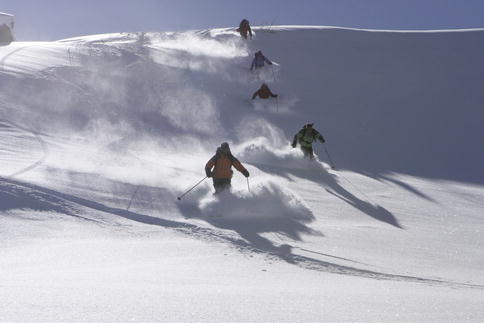
Fig. 10.2
Alpine free ride skiing
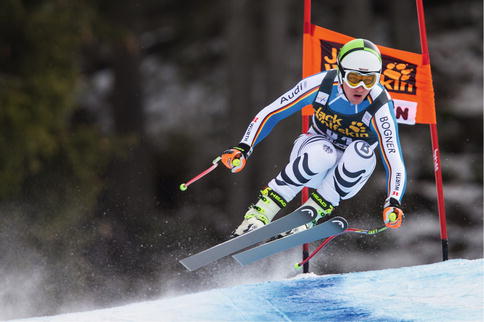
Fig. 10.3
Downhill ski racing
In Germany accidents in skiing have been documented and analyzed by an “Evaluation Authority for Skiing Accidents” (ASU) since 1979.
The first registration season has since been used as basis for the illustration of the developments in injury occurrence in ski sports. Despite a slight increase in the past season 2012/2013, the amount of injured skiers per 1.000 has decreased by more than 58 % since 1979/1980.
In spite of the overall positive developments, injuries in alpine skiing are still a challenge for the people and institutions wanting to contribute to injury risk minimization. Because ski sports can only fully unfold their positive effects with further reducing injury risk and injury severity. In the 2012/2013 season, the “Evaluation Authority for Skiing Accidents” registered a slight increase of injured skiers. Projected onto the overall collective of approximately 4,2 million German skiers, between 41.000 and 43.000 skiers can be assumed to have sustained an injury that required medical attention [33].
When the total number of injuries is subdivided by involved body regions, the knee is still the most frequently affected joint, distantly followed by the shoulder (Fig. 10.4). Subdivided by sex, the dominance of knee injuries in women is prominent with close to 50 %. Even so, in men they are still close to 30 %. Considering the development of injury distribution to the various body regions, a slight decrease of knee injuries with a simultaneous increase of shoulder and arm, torso, and hip injuries becomes apparent. The reasons therefore have not been finally resolved since larger fluctuations can be recurrently observed. Yet, there is evidence that the course of collision accidents may be a reason for these developments.
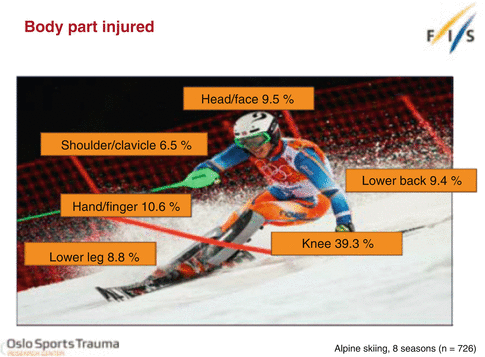

Fig. 10.4
Distribution of ski injuries on body parts
10.1.2 Injury Incidence in Ski Racing
The high injury risk in competitive skiing also poses a serious problem for the athletes. Since 2006, the FIS, together with the Oslo Sports Trauma Research Center (OSTROC), has been conducting an investigation to examine injury issues in the different Ski World Cup disciplines, to determine risk factors, and to develop efficient countermeasures.
The summary of injury frequency clearly shows the large count of injuries with at least 1–3 days of training and competing pause and severe injuries. Severe injuries are defined by a resulting training and competing pause of more than 28 days (Fig. 10.5).
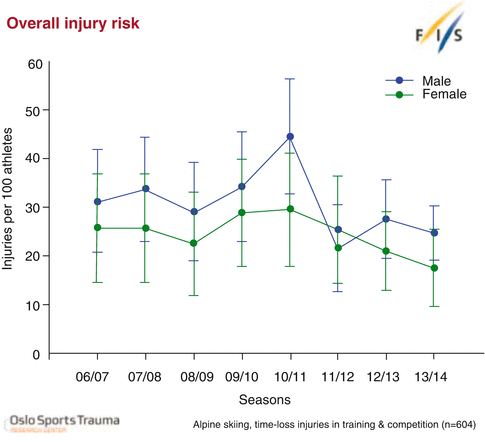

Fig. 10.5
Reported injuries per 100 athletes in alpine ski racing
The data demonstrate that almost one in every three athletes sustains an injury every season.
Considering injuries divided by gender, a slightly higher risk for injury among men is apparent. Altogether the development is subject to large fluctuations, thus making evaluation or cause analysis very hard (Fig. 10.6).
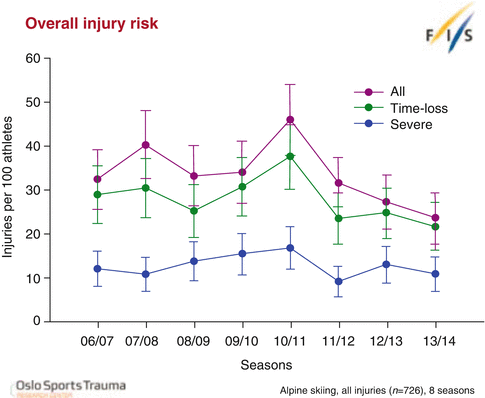

Fig. 10.6
Reported injuries male vs. female in alpine ski racing
Examined by injury localization, the data show the dominant role of knee injuries, analogous to recreational skiing. The data analysis yields a 39 % ratio of knee injuries. The ratio even rises to 60 % regarding severe injuries only.
According to the data the anterior cruciate ligament is involved in nearly half of all severe injuries and thus becomes the focus of all deliberations concerning underlying causes and injury mechanisms as well as appropriate prevention strategies.
10.1.3 Injury Patterns in Recreational and Professional Skiing
To develop efficient prevention strategies, one must know the underlying mechanisms as thoroughly as possible. Due to the dominant role of the injuries to the anterior cruciate ligament, the most work exists on this topic.
A common cause for injuries in recreational skiing is a sudden change of direction of the lower limbs in relation to the torso. In the flexed knee they result in external rotation of the lower leg with concomitant opening up of the joint on the inner side (“valgus stress”), so that the otherwise stable ligament can eventually no longer withstand the present forces. Internal rotations with an outward tilt (“varus stress”) are also possible. High velocity is not necessary here – this mechanism often leads to anterior cruciate ligament injuries at minor speed or even while standing.
The phantom foot is claimed to be the most common mechanism for ACL injuries in recreational skiing. In this situation, the skier is out of balance backward with the hips below the knees. The uphill arm is back, and the upper body generally faces the downhill ski. The injury occurs when the inside edge of the downhill ski tail engages the snow surface, forcing the knee into internal rotation in a deeply flexed position. The ski acts as a lever to twist or bend the knee, hence the term “phantom foot” [24].
A comprehensive analysis of injury mechanisms in ski racing was conducted by the Bahr group in cooperation with the FIS [5]. In this case an international group of seven experts, all biomechanists from the field of ski sports or sports physicians, examined twenty different cases of anterior cruciate ligament injuries that had been recorded within the FIS Injury Surveillance Study (ISS). Furthermore, all cases had been video documented. The experts analyzed the videos and described the injury mechanism concerning the current ski situation, behavior of the skier, and biomechanical conditions.
The group concluded that the majority of injuries can be described with three respective mechanisms. The most common one was the so-called slip-catch where the outer ski catches the inside edge, forcing the outer knee into internal rotation and valgus (Fig. 10.7). A similar loading pattern was observed for the dynamic snowplow. Injury prevention efforts should focus on the slip-catch mechanism and the dynamic snowplow [8].
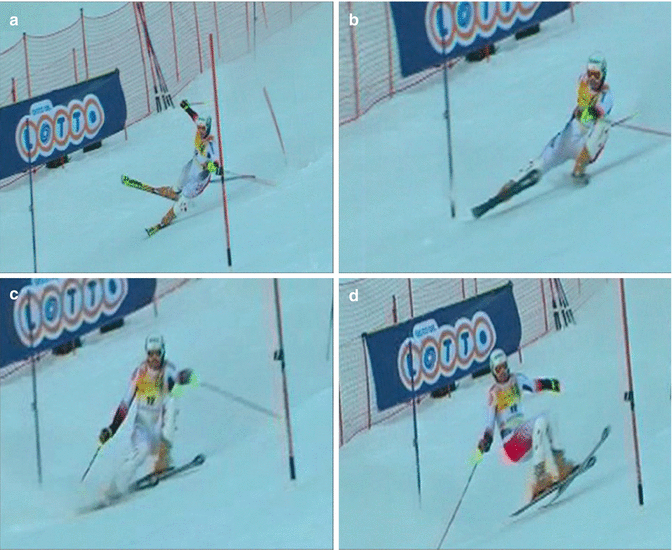

Fig. 10.7
Slip-catch (right knee). (a) (2400 ms), the skier is out of balance backward and inward in the steering phase out of the fall line. (b) (2120 ms), as the skier tries to regain snow contact with the unweighted outer ski (c), he extends his right knee (d)
The third described mechanism is typical of jumps. The athlete lands backward weighted after the jump with load to the ski tail at landing, giving it a forward rotation. The athlete tries to bring the body’s center of gravity frontward again to regain balance. The strain to the anterior cruciate ligament develops from the combination of tibiofemoral compression, the “boot-induced anterior drawer” and the quadriceps anterior drawer.
10.2 Physical and Psychological Aspects in Recreational and Professional Skiing
A resilient immune system is an important factor for injury prevention. In this context stands a balanced diet and a healthy lifestyle in general (sleep, stress, etc.) [36]. The natural cold environment may increase the risk for hypothermia as an athlete does not have a sense of thirst although he is sweating due to the increased activity. Another typical characteristic of the cold air at higher altitude is the lack of humidity. The dry air needs to be moistened with every breath the athlete takes. This causes another source for loss of humidity that needs to be considered [18]. Sufficient fluid intake, especially at high elevations, is recommended.
Alpine skiing technique has changed considerably since the 1990s. Riding tapered skis, the so-called carving technique, has become more and more popular since then and has widely superseded skiing with non-tapered skis to present. The carving technique makes it possible for skiers of nearly all skill levels to experience the appeal of radial acceleration. The power necessary to initiate and modulate the turn with earlier techniques is largely omitted today. Albeit the skier is exposed to high forces resulting from tight curve radius and small sliding portion with extensive traction rise. Speed is a substantial risk factor concerning the carving technique even more than the technique without tapered skis. The cornering forces increase exponentially with speed. A study at the University of Salzburg, commissioned by the FIS, could provide evidence for this association in high-performance competitive skiing, also [32].
Modern slope preparation enables comfortable skiing and entices to high speed. This risk factor is concurrently the main fascination of slope skiing. Apart from the sidecut, the width and preload are of essential physical importance. Wide skis enable a stronger tilt and thereby a larger edging angle.
Due to the high rate of injuries in competitive alpine skiing, the FIS regulations for ski geometry were adapted following the present investigations of the University of Salzburg [15]. Present-day competition skis are less tapered and are altogether narrower. In recreational skiing so-called “Rocker”-skis are increasingly gaining acceptance. These are wide skis that are slightly bent upward in the front ski and thus have features similar to carving skis, even without greater sidecut. “Rocker”-skis afford pleasure off the slopes, also, and facilitate skiing in deep powder snow through more float. The “Rocker”-ski combines the advantages of the carving ski with the advantages of the conventional ski. Particularly the risk to catch an edge is substantially lower with a “Rocker”-ski compared to a carving ski. Slipping away of a ski followed by uncontrolled edge grip, known under the term “Slip Catch” in ski racing, is also a common injury mechanism in recreational skiing on distinctively tapered skis.
The work of Babiel et al. [3] can give an impression on the resulting forces. These investigations could determine that in competitive ski racing the leg is loaded with compression forces of up to 7000 N during turns. This load is mainly carried by the outside leg.
Depending on the level of difficulty of slope, race course, or mountain, all skiers are exposed to the same physical demands. Yet the athletes’ constitution and stamina differ.
The physical requirements for alpine skiing and the skier’s individual abilities must be brought in line. Precautious self-assessment and assessment of these facts is the first step to reasonable prevention. Speed and turn radius determine the resulting forces which must mainly be taken by the legs and torso. Thus, high demands for the skier’s complex strength abilities arise. Apart from sufficient sense of movement, the athlete needs a capable musculoskeletal system. Compression and shear forces and bending and rotation moments are particularly applied to lower extremity joints and bony structures as well as the spine [39]. These loads can only be partially compensated by muscles and tendons and thus require a resilient passive locomotor system. Decent aerobic endurance abilities are an essential prerequisite for optimal injury prevention and protection from overload damage in both recreational and, especially, competitive alpine skiing [44].
Powerful and fully functional muscles are to be obtained and preserved by appropriate training and immediate preparative measures, such as warm-up exercises. The forced posture of the foot in the ski boot and the boot’s notch effect at the edge lead to exceptional strain in alpine skiing. Permanent flexed knee position results in large tensile forces to the patellar tendon. Extensive forces and moments are put onto the knee through eccentric loading. The spine is exposed to great compression and shear forces due to the neutralization of its physiological S form while skiing in hunched posture. The upper extremity and head are mainly at risk in the case of fall or collision.
Next to the physical condition, the mental condition is crucial to injury and overload prevention.
The balance between fascination and risk has a key function. In recreational skiing the fascination mainly results from the experience of nature, motion dynamics, and speed.
The fascination in competitive skiing results from the desire to win and the will “to push the limits.” Competitive skiers show an over proportional risk disposition. The successful ski racer knows how to manage risk on the borderline. Individual goals are essential criteria for prophylaxis in recreational and competitive skiing. Fatigue and exhaustion are accompanied by reduced concentration as well as coordination and are thus substantial risk factors. Prevention already begins with appropriate choice of equipment. Visual aspects and vanity should be set behind functional aspects. In back country skiing we should not only be guided by our emotions but also by the current avalanche warning, the weather conditions, and the terrain and snow composition.
10.3 General Aspects in Training and Competition Considering Various Techniques and Disciplines of Alpine Skiing
10.3.1 General Technical Training Aspects of Alpine Skiing
An essential prerequisite for the practice of alpine skiing at the lowest possible risk is general endurance and strength training. Warm-up of the musculoskeletal system is necessary before physical exercise and after longer pauses. Sport specific training is intended to achieve the desired level of performance. Further, the anticipation of hazardous situations is to be learned. The goal for technical sports training is executing the basic situative challenges instinctively, without activation of higher levels of awareness. Automation of motion sequences is the keyword. The capability to meet these demands with this method consists of repeating the supposed intended movement often enough to be able to execute it automatically under changing conditions. This approach is based on the principles of instruction and repetition. The exercise instructor gives motion tasks and corrects their execution. This instructor feedback does not require integral neuromotor processes; thus, their formation is not furthered. This model of learning is commonly found in recreational skiing and classic skiing instruction. In modern motion studies, elements of differential learning are used [31]. The trainer creates situations for the athlete and helps him find solutions. This form of intuitive learning focuses on experiencing and mastering the individual motion optimum by executing the movement in various, even extreme forms. Errors are not avoided; instead they help develop individual motion strategies. A training method is serving to form neuromotor pathways and, thus, multiple neuromotor connections for automated handling of as many situations as possible. This stimulates a self-organizing learning process, eventually making learning by sole motion execution possible, even without a trainer [40]. Alpine skiing is essentially a technomotoric sport. Learning of sports-specific motion sequences is also an elementary basis of this sport concerning prevention [37]. This form of training can be effective in recreational skiing, too. Recreational skiers are also confronted with different challenges, such as different terrains, slope conditions, snow quality, and slope frequenting by other skiers. For the purpose of optimal injury and strain prevention, a situationally adapted technique is helpful. The athlete is to learn and consider signs of fatigue within the scope of risk management.
10.3.2 General Aspects in Training and Competition in Various Disciplines of Alpine Skiing
According to Bahr et al. [5], the risk factors for a sports injury are derived from the intrinsic risk factors, which are specific to the athlete, and the extrinsic risk factors, depending on equipment and conditions. By means of a triggering event, a combination of these factors leads to an injury. A similar coherence can be assumed for overload syndromes.
Endurance capacity is also essential in terms of prevention. The competitive alpine skier’s metabolism not only has to be able to mobilize enough energy to meet the specific demands but must also provide for a muscular milieu, concerning pH regulation, that can enable required fine motor skills [41].
Which active mechanisms serve the prevention of injuries and excessive strain with due regard to the different competitive disciplines?
Slalom: particular requirement for this discipline is strength, explicitly springiness, since high-frequency movement cycles take place with turn durations of less than a second. The main challenge for the slalom skier is maintaining dynamic balance under ever changing conditions and the demand to lose as little speed as possible. In order to do so, he must constantly adapt the body’s center of gravity and, thus, the point of load to the ski in the frontal and sagittal plane to the specific situation. These measures are used to precisely keep the ski on the edge to minimize friction and to utilize the ski’s dynamic potential. The competitions last about 50 s. In this context the following factors of active prevention are essential:
Optimization of mental and motor agility using training methods from the fields of coordination training or Life Kinetik® [17]
Training of springiness under consideration of high contraction speeds (no terminal extension of joints, no maximal motion speed)
Optimization of the interaction between eccentric and concentric motion sequences
Specific training of endurance and force perseverance
Torso-stabilizing training to counteract the whiplash-like inertia torque during turn changes
Giant slalom: compared to slalom there are higher speeds of up to 80 km/h and larger radii. As a result, the turn exposure time increases, but not the sum of acting forces. The competitions last about 80 s. Specific active prevention criteria:
Optimization of mental and motor agility using training methods from the fields of coordination training or Life Kinetik® [17]
Training of springiness under consideration of high contraction speeds and great holding forces
Optimization of the interaction between eccentric and concentric motion sequences
Specific training of endurance and force perseverance
Extremely high movement precision due to the specific geometry of giant slalom skis that are moved at their absolute performance limit during turns
Speed disciplines (Super-G, Downhill): extreme alertness is needed here due to the changing terrain and the different sight and light conditions in combination with high speed.
The high speeds of up to 120 km/h expose the athletes to great forces of up to 7000 N [3] on turny course segments and landing after jumps. Specific demands:
Optimization of risk management regarding the fact that competition conditions can frequently not be simulated in training. Course lengths, course preparation, and technical requirements are different in every race. Still, the race courses cannot be used for training. Considering the aforementioned criteria, the training courses are distinctly less demanding than the race courses. The athletes must be acquainted with competition conditions using speed elements. An important prevention measure is the athlete’s perception of a manageable competition situation.
Stay updated, free articles. Join our Telegram channel

Full access? Get Clinical Tree








